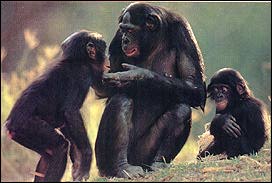 Science
in Christian Perspective
Science
in Christian Perspective Science
in Christian Perspective
Science
in Christian Perspective
Bonobo Trails
G. R. Morton,
Dallas, TX 75248
From: PSCF 50 (June 1998): 84.
An Internet news report, E-VOLUTION, 2:2, Feb. 1998, reported that Sue Savage-Rumbaugh of Georgia State University has observed bonobos (Pan paniscus) marking their trails so other bonobos could follow. During the day, the approximate one hundred members of a bonobo troup will spread out in order to avoid predators. At night the troup gathers once again to sleep.
The report stated that Savage-Rumbaugh observed bonobos
placing crushed leaves and stripped branches on the ground where two trails
intersected. These markers were used by the lead group as a sign to tell
stragglers which trail to take. This was only done when the ground was not muddy
enough for footprints to be left by the lead group. To make the case, Savage-Rumbaugh
twice used the markers to tell her where the bonobos had gone. She was able to
find the assembled and sleeping bonobos. In addition to leaving markers where
the trails cross, they also left markers when a tree trunk obstructed the path.
If the lead group crossed the trunk, plants would be smashed on both sides of
the tree. If the lead troup walked along the top of the trunk to another trail,
the plants would be smashed only on one side of the tree trunk.
ground where two trails
intersected. These markers were used by the lead group as a sign to tell
stragglers which trail to take. This was only done when the ground was not muddy
enough for footprints to be left by the lead group. To make the case, Savage-Rumbaugh
twice used the markers to tell her where the bonobos had gone. She was able to
find the assembled and sleeping bonobos. In addition to leaving markers where
the trails cross, they also left markers when a tree trunk obstructed the path.
If the lead group crossed the trunk, plants would be smashed on both sides of
the tree. If the lead troup walked along the top of the trunk to another trail,
the plants would be smashed only on one side of the tree trunk.
Obviously, this form of communication raises interesting questions concerning the nature of language in a genetically closely related species. While this is clearly not symbolic communication in the sense that a human language is, it is communication of a complex variety and is obviously an aid in social cohesion.
©1998